|
|
![]()
 Paper Mache Volcano
Paper Mache Volcano
Over Christmas vacation 2004 I was looking for a project to work on with Christopher that would take a few days to complete but would keep his attention. In order to keep this 3 year old's attention it would have to involve a number of different activities, each of which need to be pretty simple and not take too long to complete. We settled on building a working paper mache volcano, that would in Christopher's terminology "have lava shooting out the top". I'm not sure about lava "shooting" out the top but we would try to make sure that it would have some lava coming out by the end of the project.
Day 1
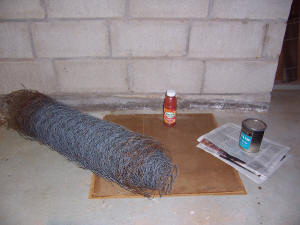 This
volcano has a pretty basic design using materials we had around the house.
I found a old piece of hardboard about 2 ft by 2 ft for the base. The lava
tube was going to be a juice bottle in this case a 16oz grapefruit bottle (minus
the juice) placed in the middle. For the framework of the volcano I was
going to use some old chicken wire, some paper for the paper mache and some old
paint for a nice relatively waterproof finish. I spent a little bit of
time trying to find a suitable bottle to use as the lava tube, I wanted a
narrowed top so that as the lava comes out it wouldn't just slowly flow out, but
had a little bit of force behind it. However, to avoid having lava
launched up to the ceiling, I was conservative with my choice.
This
volcano has a pretty basic design using materials we had around the house.
I found a old piece of hardboard about 2 ft by 2 ft for the base. The lava
tube was going to be a juice bottle in this case a 16oz grapefruit bottle (minus
the juice) placed in the middle. For the framework of the volcano I was
going to use some old chicken wire, some paper for the paper mache and some old
paint for a nice relatively waterproof finish. I spent a little bit of
time trying to find a suitable bottle to use as the lava tube, I wanted a
narrowed top so that as the lava comes out it wouldn't just slowly flow out, but
had a little bit of force behind it. However, to avoid having lava
launched up to the ceiling, I was conservative with my choice.
The first step was to assemble the lava tube. In the end I decided to use two juice containers, I cut the top off the bottom one then hot melt glued and taped them together. The tube was about 1.5' tall and was then glued in the middle of the base.

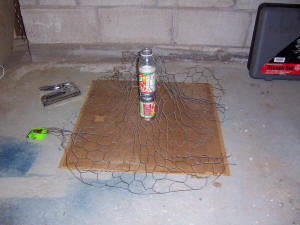
A piece of chicken wire about 3' square was draped over the tube and roughly formed into place.
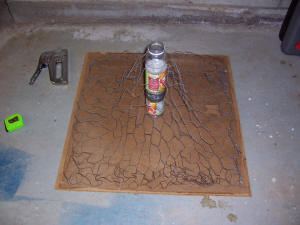 Next,
the chicken ware was stapled around the perimeter to the base. During this
process I tried to create a good volcano shape. This entailed creating
some creases and valleys in the chicken wire surface so the end volcano would
not be too smooth and artificial looking.
Next,
the chicken ware was stapled around the perimeter to the base. During this
process I tried to create a good volcano shape. This entailed creating
some creases and valleys in the chicken wire surface so the end volcano would
not be too smooth and artificial looking.
It it tough to see at this stage, but I also created a berm or wall on the outer edge of the volcano with the chicken wire. The purpose of this was to contain the "lava" once it had run down the volcano and to prevent it from going all over the place.
Day 2
It is now time to start building the surface of the volcano. For this I decided to use good old paper mache. We cut up a bunch of strips of newpaper in about 1" widths. For the "glue" I mixed flour with water until it had a paste type consistancy. (I also squeezed in a little bit of white glue just in case a little extra holding power was required. I'm sure the glue was not really necessary.)

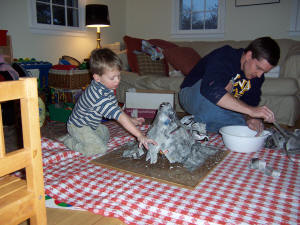
Now the fun can really begin, Christopher was able to build quite a bit of the volcano surface by himself, with a bit of help from Daddy and Mommy. You can see here the large pile of newspaper strips, bowl of flour glue and the volcano beginning to take shape. It gets pretty messy so we built it on an old picnic tablecloth. It goes pretty easily if the paper is well saturated with the glue and all excess is squeezed off before it is placed on the chicken wire base.

Here is the completely surfaced volcano. You can kind of make out all the crevasses that were formed into the volcano by creasing the chicken wire. I kind of over did it a little on the left side, where it appears the volcano is caving in a bit, but overall not too bad. Christopher did a great job covering it and I think during this picture was in the bathroom getting cleaned up. He managed to get the "glue" all over himself, but luckily not on the furniture.
Day 3

OK, the volcano dried overnight and is ready for the next stage: painting. (Now the berm around the volcano can clearly be seen.)
I expanded the picnic tablecloth a bit when painting started, Christopher is not known for being too neat when it comes to paint. Standard black gloss latex paint was used (mainly because that it what we had around).
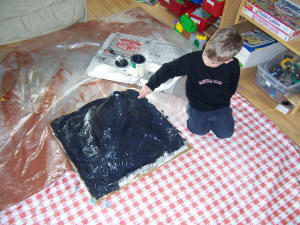

Excellent job by Christopher on the painting, after a few hours for drying we have a finished volcano...

Day 4
After the volcano dried overnight we were ready to start the most exciting part of all, the LAVA!
Since we wanted a real working volcano I decided to try a vinegar and baking soda mixture. By putting some food dye in the vinegar we could make pretty much any color lava we wanted, and we should be able to get some nice lava flow from the reaction. The liquid mixture consisted of ~16 oz vinegar, a few drops of red food coloring and a few squirts of liquid disk soap. The soap is a crucial ingredient that will hold all the bubbles created by the vinegar-baking soda reaction and create a some nice volume.


Here we are adding the ingredients, first the red liquid mixture goes into the lava tube. Then, we add the baking soda and ....

Hey, nothing is coming out....is it broken???
No, the lava begins to flow a few seconds later.
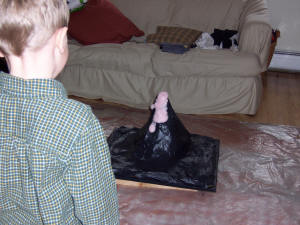


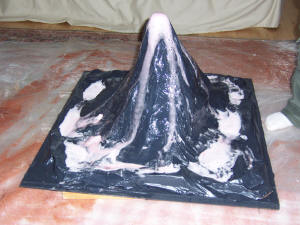
A pretty nice first volcano run. Christopher was quite pleased with the result even though the lava did not quite "shoot out the top" as he had first requested. Of course now (being a 3 year-old) he constantly wants to try more lava with different colors and also wants to build more of them.
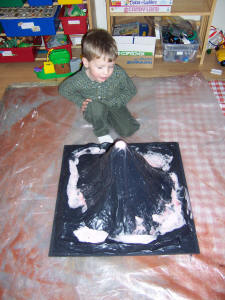
Proud volcano owner with his creation.
Here is a short video of an eruption with green lava:
Click on the picture to view a Windows Media format file which is ~4.2MB in size. A broadband connection is recommended.
P.S. That berm around the edge was a good idea, if I do say so myself.
This site was last updated 02/03/05